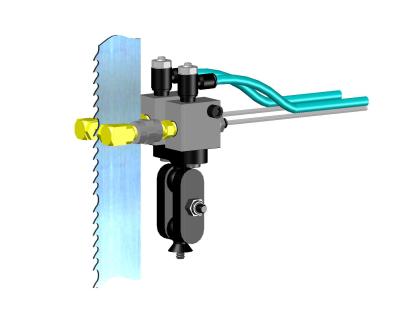
AMCOL Corp. introduces electronic control and PLC (Programable Logic Controller) integration to its 6000 series precision lubrication systems for true minimum quantity lubrication (MQL). MQL incorporates extremely accurate spray equipment to place minute amounts of concentrated lubricants to the cutting tool/workpiece interface to maximize tool life and provide a near dry environment. Applications include sawing, machining, forming, piercing and stamping.
By adding electronic control, AMCOL’s 6000 series can be programmed through a PLC to provide an unprecedented level of control over the amount and timing of lubricant application, permitting more precise MQL application. The injector used in the 6000 series can dispense liquid in as little as 20ms, this immediate reaction time can keep up with the quickest and most demanding machine cycle rates, and PLC control means it happens when and only when you need it.
PLC control also allows “recipe” programming for today’s flexible short run manufacturing environment. This updated technology can be programmed for different tooling, operation speed, part size, and metals and alloys in the same machine. No more setting and resetting for different parts or one generic lubricant setting for all tools and parts, helping to reduce set up times, part changeover, lubricant consumption and residue.
The chemistry behind the equipment is also critical. CANMIST high-performance concentrates are specifically-developed for minimum quantity and maximum performance. These high-grade lubricants do not require dilution, making fluid management easier and less expensive.
Contact Details
Related Glossary Terms
- alloys
alloys
Substances having metallic properties and being composed of two or more chemical elements of which at least one is a metal.
- concentrates
concentrates
Agents and additives that, when added to water, create a cutting fluid. See cutting fluid.
- sawing
sawing
Machining operation in which a powered machine, usually equipped with a blade having milled or ground teeth, is used to part material (cutoff) or give it a new shape (contour bandsawing, band machining). Four basic types of sawing operations are: hacksawing (power or manual operation in which the blade moves back and forth through the work, cutting on one of the strokes); cold or circular sawing (a rotating, circular, toothed blade parts the material much as a workshop table saw or radial-arm saw cuts wood); bandsawing (a flexible, toothed blade rides on wheels under tension and is guided through the work); and abrasive sawing (abrasive points attached to a fiber or metal backing part stock, could be considered a grinding operation).

